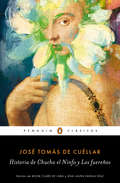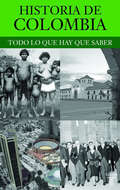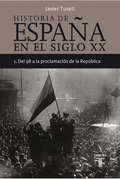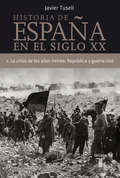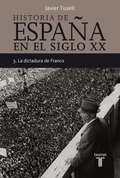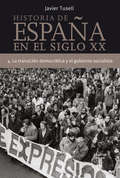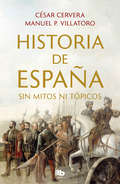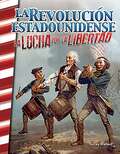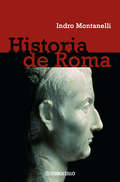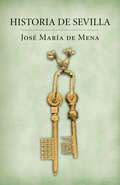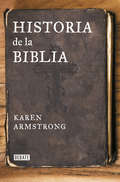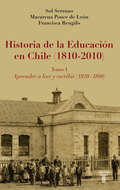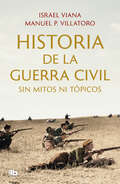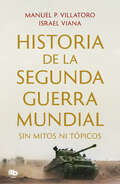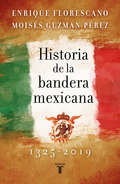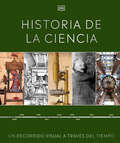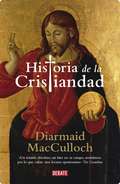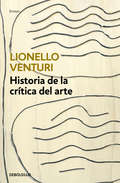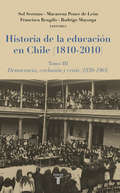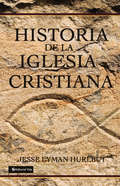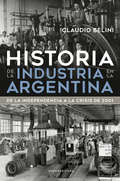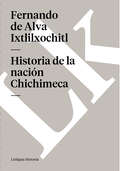- Table View
- List View
Historia de Chucho el Ninfo y Los fuereños
by José Tomás de CuéllarUn volumen que reúne dos de las novelas más destacadas del gran novelista mexicano del siglo XIX, José Tomás de Cuellar. Edición a cargo de Belem Clark de Lara y Ana Laura Zavala Díaz, investigadoras del Seminario de Edición Crítica de Textos del Instituto de Investigaciones Filológicas de la UNAM y especialistas en la literatura mexicana del siglo XIX. "Chucho repugnaba la acentuación varonil y combatía en su fisonomía la venida de esas líneas que deciden el aspecto viril" En Historia de Chucho el Ninfo, José Tomás de Cuéllar evidencia las desastrosas consecuencias, morales y sociales, del deterioro de las costumbres de la sociedad de su tiempo, que producía niños como Chucho, mimados en extremo y entregados sólo al culto desmedido de la belleza y la superficialidad. Completa el volumen la novela corta Los fuereños, en la que Facundo relata, con el humor y la agudeza crítica que lo caracterizó, las peripecias y dificultades que enfrenta una familia del interior de la república en una ciudad de México en pleno proceso de modernización.
Historia de Colombia
by Autores VariosEn este libro la historia de Colombia se presenta linealmente y por períodos -Descubrimiento, Conquista, Colonia, etc.-, que es la manera más práctica y eficaz de entenderla. Pero los autores, que son historiadores, sociólogos, antropólogos, también se ocupan de esa otra historia implícita en los períodos, la historia menos convencional, la que se lee entre líneas. Se empeñan en desentrañarla, sin hacer concesiones, yendo mucho más allá de lo descriptivo y aportando valiosísimos elementos de análisis, valientes críticas y cuestionamientos, pues parecen de acuerdo en que una nueva historia de Colombia debe ser narrada. Autores: Luis Enrique Rodríguez, Ana Luz Rodríguez, Jaime Humberto Borja, Diana L. Ceballos, Carlos Uribe, Amparo Murillo y Ricardo Arias. Prólogo: Carlos José Reyes
Historia de España en el siglo XX - 1: Del 98 a la proclamación de la República
by Javier TusellUna obra fundamental para entender la España de hoy. Dividida en cuatro volúmenes, la Historia de España en el siglo XX abarca un periodo especialmente controvertido, cuyo conocimiento es imprescindible para cualquiera que desee hacer un diagnóstico del presente. España ha sido protagonista de dos acontecimientos fundamentales en este siglo - la Guerra Civil y la transición a la democracia - y la cultura española ha alcanzado desde comienzos del siglo XX unas cotas que permiten establecer un paralelismo con el Siglo de Oro. Este primer tomo aborda la etapa comprendida entre el desastre de 1898 y la proclamación de la República en 1931, un periodo de cambio en el que empezaron a fraguarse las grandes cuestiones que marcaron el siglo XX español.
Historia de España en el siglo XX - 2: La crisis de los años treinta: República y Guerra Civil
by Javier TusellUna obra fundamental para entender la España de hoy. Dividida en cuatro volúmenes, la Historia de España en el siglo XX abarca un periodo especialmente controvertido, cuyo conocimiento es imprescindible para cualquiera que desee hacer un diagnóstico del presente. España ha sido protagonista de dos acontecimientos fundamentales en este siglo: la Guerra Civil y la transición a la democracia; y la cultura española ha alcanzado desde comienzos del siglo XX unas cotas que permiten establecer un paralelismo con el Siglo de Oro. Este segundo volumen estudia la crisis de los trascendentales años treinta, en los que la Segunda República y la Guerra Civil marcaron la vida de los españoles.
Historia de España en el siglo XX - 3: La dictadura de Franco
by Javier TusellUna obra fundamental para entender la España de hoy. Dividida en cuatro volúmenes, la Historia de España en el siglo XX abarca un periodo especialmente controvertido, cuyo conocimiento es imprescindible para cualquiera que desee hacer un diagnóstico del presente. España ha sido protagonista de dos acontecimientos fundamentales en este siglo - la Guerra Civil y la transición a la democracia - y la cultura española ha alcanzado desde comienzos del siglo XX unas cotas que permiten establecer un paralelismo con el Siglo de Oro. En este tercer volumen se analizan las distintas etapas de la dictadura de Franco, desde la represión de la postguerra hasta el desarrollo económico y la apertura final del régimen.
Historia de España en el siglo XX - 4: La Transición democrática y el gobierno socialista
by Javier TusellUna obra fundamental para entender la España de hoy. Dividida en cuatro volúmenes, la Historia de España en el siglo XX abarca un periodo especialmente controvertido, cuyo conocimiento es imprescindible para cualquiera que desee hacer un diagnóstico del presente. España ha sido protagonista de dos acontecimientos fundamentales en este siglo - la Guerra Civil y la transición a la democracia - y la cultura española ha alcanzado desde comienzos del siglo XX unas cotas que permiten establecer un paralelismo con el Siglo de Oro. Este cuarto y último volumen cubre un periodo fundamental para la España actual: la transición democrática y el primer gobierno socialista.
Historia de España sin mitos ni tópicos
by César Cervera Manuel P. VillatoroUn recorrido didáctico y rico por los grandes hechos y personajes que marcaron la historia de España. Los mitos han perseguido a España desde que Escipión Emiliano sitió Numancia. Durante los siguientes siglos se han esgrimido una retahíla de falacias sobre este país que, a golpe de repetirse, han forjado la llamada Leyenda Negra. Este libro se enfrenta a todas ellas. Desde la idea de que la brutalidad campó a sus anchas a partir del siglo XVI, hasta la que muestra a los conquistadores como bárbaros sedientos de sangre. Con la veracidad y el rigor de los datos por estandarte, y bajo la premisa de buscar siempre una divulgación amena, los periodistas César Cervera y Manuel Villatoro abordan en estas páginas las gestas más reconocidas de las tropas españolas a lo largo de dos mil años, las peripecias más llamativas de los monarcas que han dirigido este país o, entre otras muchas cosas, los hitos más destacados de su pasado. Un paseo rico y fascinante para acercarnos un poco más al relato más apasionante de todos: el de nuestra historia. Algunos lectores ilustres han dicho...«Un ramillete de artículos que responden a la máxima horaciana de enseñar deleitando (prodesse et delectare). ¿Qué más se puede desear?»Juan Eslava Galán «César Cervera y Manu Villatoro convierten la historia de España en noticia de portada que no te puedes perder. ¡Imprescindible!»Isabel San Sebastián «Estos jóvenes periodistas han conseguido contar la historia de España como si fuera el mejor de los reportajes: riguroso, ágil, veraz, informativo y ameno.»Antonio Pérez Henares
Historia de La Revolución estadounidense La lucha por la libertad: Libro en español para niños
by Torrey MaloofGive ESL students a truly unique reading and learning experience through primary sources! This history book for kids helps students make personal connections to history. <P><P> Primary sources provide insight into what life was like during the American Revolution. Students will learn about Paul Revere, the minutemen, Valley Forge, and the battles of Lexington, Concord, and Bunker Hill. Features include:
Historia de Los primeros exploradores (Social Studies: Informational Text Series)
by Heather E. SchwartzHistoria de Roma
by Indro MontanelliHistoria de Roma ofrece una serie de retratos apasionantes y veraces que iluminan en sus justos términos a los protagonistas de aquella época irrepetible. Los próceres y las personalidades de Roma no eran distintos del común de los mortales. César fue un mujeriego toda su vida y se avergonzaba de su calvicie, pero eso no desmerece su grandeza militar y estadista. Augusto no dedicó todo su tiempo a organizar el Imperio, sino que parte del mismo lo ocupó en combatir la colitis y los reumatismos...
Historia de Sevilla
by José María MenaUna obra que recoge todos aquellos testimonios históricos que conforman la biografía global de Sevilla, por un escritor que lleva décadas al servicio de la historia de la ciudad.
Historia de Sevilla
by José María MenaUna edición actualizada y ampliada de Historia de Sevilla, ilustrada con nuevas fotografías y material inédito aportado por el autor. José María de Mena, el más célebre historiador de Sevilla, recorre en esta obra la historia de esta gran ciudad andaluza, remontándose a los esplendorosos y enigmáticos tiempos de los tartesios. Mena nos ilustra sobre la fundación fenicia de Sevilla y su conversión en Hispalis, capital bética de la Hispania romana. Sevilla destacó durante la época visigoda por la figura de san Hermenegildo, considerado el rey de Andalucía, y en la Edad Media acogió al célebre arzobispo san Isidoro. Tras la derrota en tierras andaluzas de don Rodrigo, la ciudad se adentró en el período musulmán, durante el cual Sevilla no perdió ni un ápice de su importancia histórica. De hecho, la corte de Motamid, el rey poeta de Sevilla, brilló por ser la más suntuosa de la época y por contar con la presencia de los artistas y rapsodas más destacados del mundo islámico. La Reconquista cristiana y el descubrimiento de América devolvieron a la ciudad el protagonismo que le correspondía. La Exposición Iberoamericana de 1929, la Exposición Universal de 1992, la celebración del V Centenario del descubrimiento del continente americano... Sin lugar a dudas, la historia de Sevilla atesora un acervo cultural, político y económico de gran calado, a la altura de las más grandes ciudades europeas.
Historia de la Biblia
by Karen ArmstrongLa historia del libro más importante de todos los tiempos contada por Karen Armstrong, la mayor experta en religiones del mundo. La Biblia es el libro más famoso del mundo. Traducido a más de dos mil idiomas, se calcula que ha vendido más de seis mil millones de ejemplares solo en los últimos dos siglos. En esta excepcional crónica, Karen Armstrong sigue la creación de la Biblia para revelar un texto complejo y contradictorio, escrito por docenas de personas a lo largo de cientos de años. Armstrong comienza su análisis por los libros más antiguos de la Biblia hebrea, en los que Dios aparecía indistintamente como «Yahvé» y «Elohim», para seguir con el desarrollo del Antiguo y del Nuevo Testamento y sacar a relucir las distintas influencias que contribuyeron a dar forma a estos textos sagrados. Desde la práctica judía de la Midrás y el culto cristiano de Jesús hasta la influencia de las epístolas de san Pablo en la Reforma protestante y la manipulación del imaginario del Apocalipsis por el fundamentalismo cristiano, Armstrong explora el contexto en que estos sesenta y seis libros han sido interpretados y explica las necesidades sociales que buscaban satisfacer. El resultado revela una obra paradójica y desconocida, y cambiará para siempre nuestra visión de la Biblia. La crítica ha dicho... «Una excelente historia, amena y fascinante.»Julie Wheelwright, Independent
Historia de la Educación en Chile (1810 - 2010): Tomo I. Aprender a leer y escribir (1810 - 1880)
by Sol Serrano Macarena Ponce de Léon Francisca RengifoEn la primera mitad del siglo XX, la educación expandió la democracia, pero no logró modificar la estructura social: los más pobres se mantuvieron excluidos y el sistema económico apenas contribuyó a la movilidad social. Por ello, en este libro se sostiene que el sistema educacional fue una exitosa tarea política y cultural, más que social y económica. Entre 1880 y 1930 la educación fue el centro de las transformaciones sociales y se constituyó en el principal agente democratizador de la sociedad chilena. La cobertura escolar creció a un ritmo inusitado, no obstante las dificultades inherentes a la pobreza de la población. Así, la Ley de Educación, que estableció la obligatoriedad escolar, inauguró las políticas sociales en el país. La escuela pública se institucionalizó, llegó a más niños, y estos aprendieron más y mejor. La educación también permitió el ingreso de nuevos actores al espacio público: las mujeres se incorporaron a la educación secundaria, el movimiento obrero creó sus propias escuelas y los niños mapuches, aunque pocos, pudieron reivindicar sus derechos.
Historia de la Guerra Civil sin mitos ni tópicos
by Manuel P. Villatoro Israel VianaLa historia de la Guerra Civil como jamás nos la han contado, con una mirada experta y al mismo tiempo muy cercana. En Historia de la Guerra Civil sin mitos ni tópicos, Manuel P. Villatoro e Israel Viana repasan los años treinta del siglo XX para entender el enfrentamiento capital de nuestra historia reciente, la cruenta guerra civil que antecedió a uno de los períodos más convulsos del siglo XX en España y Europa. Con un enfoque fresco y renovador, los autores nos descubren los entresijos del conflicto explicándonos cómo se gestó, cómo se desarrolló y cómo finalizó, sentando las bases de la dictadura. Al igual que el anterior Historia de España sin mitos ni tópicos, este nuevo libro se acerca al lector con un espíritu dinámico, desenfadado y a la vez riguroso, a fin de contar la historia como jamás se ha contado.
Historia de la Segunda Guerra Mundial sin mitos ni tópicos
by Israel Viana Manuel P. VillatoroLa historia de la Segunda Guerra Mundial como jamás nos la han contado, con una mirada experta y al mismo tiempo muy cercana En Historia de la Segunda Guerra Mundial sin mitos ni tópicos, Manuel P. Villatoro e Israel Viana, periodistas especializados en historia, nos acercan al conflicto más grande de todos los tiempos bajo la premisa de una pulgación fresca y amena, en la que se incluyen varias exclusivas jamás contadas, fruto de la investigación de los autores. Sin olvidar los hechos previos al enfrentamiento, ni sus largas consecuencias en el corto siglo XX, el libro ofrece una crónica de la guerra año por año, atenta a sus entresijos y al enorme sufrimiento humano que supuso. Se encontrarán aquí entrevistas con algunos de los últimos supervivientes y los acontecimientos bélicos más destacados, como la invasión de Polonia por las tropas del Tercer Reich o las asfixiantes batallas marítimas en el interior de los submarinos, pero también aparecerán pinceladas sobre detalles como el funcionamiento del Panzer, las obsesiones eróticas de Hitler y Mussolini, el desempeño de las mujeresespías en el frente o el desesperado encargo hecho por el Kremlin a Dmitri Shostakóvich de estrenar su Sinfonía n.º 7, con una orquesta diezmada, en la ciudad sitiada de Leningrado. Villatoro y Viana, dos colosos del periodismo, nos ofrecen una historia a escala humana, inteligente y ágil, capaz de desvelar la realidad política y personal de un pasado que no deja de ser noticia. Sobre el volumen: desconocidos de la Segunda Guerra Mundial».
Historia de la bandera mexicana 1325 - 2019
by Enrique Florescano Moisés Guzmán Pérez«Para distinguir la insignia se acudió a la fuerza del emblema indígena y esa decisión volvió a unir a la nación, proyectada hacia el futuro con sus raíces más antiguas.» Contar la historia de la bandera mexicana implica recorrer un largo proceso de choque y fusión de símbolos de identidad. Desde los orígenes prehispánicos del escudo nacional, pasando por la prohibición y triunfo del emblema indígena durante el virreinato, la Independencia y la adopciónde los colores de la bandera del Ejército Trigarante, la unificación de los símbolos patrios en el porfiriato, los avatares de la bandera y el escudo durante la Revolución, hasta llegar al establecimiento del Día de la Bandera y la más reciente legislación sobre las características y el uso del escudo, la bandera y el himno. Este libro cuenta esa historia de cambios y permanencia de forma tan erudita como entrañable. Una bandera puede representar unidad, independencia o los valores nacionales más estimados. Lo particular de la bandera mexicana es que en su creación participaron tres tradiciones diferentes: la indígena,la religiosa hispánica y colonial, y la tradición liberal que se propuso fundar estados autónomos y soberanos. Contra la idea de una posición indígena inerte, este libro muestra que en la época colonial y en las primeras décadas del siglo xix los grupos indígenas y mestizos defendieron tenazmente sus símbolos de identidad y mantuvieron un diálogo horizontal con los legados procedentes de Europa. Asimismo, esta historia de la bandera mexicana -ricamente ilustrada- constata que los símbolos visuales siempre han sido los transmisores más eficaces de mensajes políticos y culturales para la sociedad.
Historia de la ciencia (Timelines of Science): Un recorrido visual a través del tiempo
by DKExplora el mundo de la ciencia como nunca antes en esta guía profusamente ilustrada.La historia de la humanidad ha avanzado gracias a los descubrimientos científicos. Desde que nuestros antepasados ??aprendieron a usar herramientas y fuego hasta los avances modernos que han dado forma al mundo en el que vivimos, la ciencia ha definido nuestra historia a lo largo de miles de años. Con bellas ilustraciones y textos claros y fáciles de leer, 'Historia de la ciencia' recorre la historia de la ciencia en todo el mundo y profundiza en la historia de las ideas, prácticas y progresos científicos. Con un enfoque visual y accesible único, este libro muestra como nunca antes cómo se originaron las ideas científicas clave y cómo han dado forma a nuestras vidas.Discover the world of science as never before in this richly illustrated guide.The history of humankind has been driven by scientific discovery. From our distant ancestors learning to use tools and fire for the first time, to the modern breakthroughs that have shaped the world we live in today, science has defined the story of humans for thousands of years. Using beautiful illustrations and clear, easy-to-read text, Timelines of Science explains the history of science as it unfolded around the world, and delves into the story of scientific ideas, practice, and progress one step at a time. Offering a uniquely accessible and visual approach, this book shows as never before where scientific ideas came from and how they have shaped all of our lives.
Historia de la cristiandad
by Diarmaid MaccullochEn cada generación, un historiador escribe la obra clave que servirá para definir las siguientes décadas de trabajo en su disciplina. Escrita con desbordante erudición y habilidad narrativa, la Historia de la Cristiandad de Diarmaid MacCulloch será sin duda un libro de referencia, la primera historia global de la religión cristiana.Esta impresionante obra, ganadora del premio Cundill de Historia, el más importante del mundo, se ocupa de la Cristiandad desde sus orígenes en el judaísmo y aborda los principales ejes de la fe cristiana. Al seguir la evolución del cristianismo y sus ramificaciones, examina cuestiones casi olvidadas sobre el mensaje de Jesús y la compilación del Nuevo Testamento, así como su difusión por todos los rincones del planeta: África, Asia, América o Europa. Es un libro que abarca la historia intelectual de esta religión, sin olvidarse de monjes y cruzados, santos y herejes, traficantes de esclavos y abolicionistas, y que nos revela el papel esencial del cristianismo en la Ilustración o durante las guerras mundiales.Vivimos una época de intensa conciencia religiosa salpicada de actos violentos que se ejecutan en nombre de Dios, y en la que creyentes y no creyentes cuestionan valores como la religión y la tradición. Este imponente libro marca un nuevo hito en la historia de una fe que sigue modelando nuestro mundo."Una combinación casi perfecta de destreza narrativa y rigor analítico."Jurado del premio Cundill
Historia de la crítica del arte
by Lionello VenturiEl ensayo más célebre de uno de los intelectuales y pensadores más decisivos de la historia del arte contemporánea. Las páginas del presente libro abarcan un vastísimo período que va de la era clásica a la contemporánea. Sin limitarse únicamente a señalar y comentar textos pertenecientes explícitamente a la denominada literatura artística, esta rica y amplia investigación ofrece una pormenorizada historia de las ideas, de las teorías, de las apreciaciones, de la toma de posición que atañe al arte figurativo desde hace siglos. La actitud de los críticos, de los pensadores, de los artistas es analizada con la intención de destacar el curso cambiante de las reflexiones sobre el arte y hacer emerger sus momentos cruciales, restituyendo así la condición misma del arte a lo largo de la historia. Reseña:«El gran Lionello Venturi, en Historia de la crítica del arte, lamentaba la dicotomía planteada, en el mundo moderno, entre historia y crítica de arte. Tal conflicto, años después de su advertencia, continúa vigente.»Francisco Calvo Serraller, El País
Historia de la educación en Chile (1810-2010) Tomo III
by Sol Serrano Macarena Ponce de LéonEl tercer tomo de este ambicioso proyecto se introduce en el periodo más convulsionado (1930-1960) del siglo XX Si en el segundo tomo se constató que el sistema educativo fue exitoso en términos políticos y culturales, en este volumen vemos, más bien, cómo la educación se enfrentó, sobre todo, a las bondades y restricciones de la productividad económica y su impacto en el desarrollo social. Si en el periodo analizado los discursos enfatizaban las «reformas» llevadas a cabo por los gobiernos del Frente Popular, luego se comenzó a hablar de «crisis», yes que los deficientes resultados de los estudiantes, el alzadel analfabetismo o el aumento de la deserción escolar, «desarrollaron un malestar social, una crítica que fue conceptualizada como una especie de desajuste crónico entre la aspiración de un cambio en la estructura social y cultural del país, por una parte, y el desarrollo económico y sus resultados por otra». Las movilizaciones estudiantiles de los cincuenta y sesenta no solo son una expresión de este descontento: son al mismo tiempo el anuncio de un malestar por venir, aun mayor, una crisis que dio inicio a una nueva etapa en nuestra historia.
Historia de la iglesia cristiana
by Jesse Lyman HurlbutNinguna institución ha cubierto más siglos y más continentes que la iglesia cristiana. Su historia dramática es de derramamiento de sangre y paz, corrupción y pobreza. Aquí el doctor Hurlbut vuelve a contar esta historia con un estilo objetivo, conciso y claro, haciendo énfasis en el espíritu de la iglesia, su crecimiento y maduración, y las causas que condujeron a los acontecimientos históricos y su influencia resultante. Preciso, al día, y presentado en forma vívida, Historia de la Iglesia Cristiana, de Hurlbut, cubre los seis períodos generales de la historia de la iglesia desde el año 30 d. C. hasta el día de hoy. En esta edición revisada después de la muerte del doctor Hurlbut, se ha añadido una sección de conclusión que abarca el período desde el fallecimiento del autor hasta la actualidad para darnos un vistazo completo y fácil de entender acerca de la iglesia cristiana. Diseñado para dos públicos, este libro contiene bosquejos y referencias en los márgenes para ayudar al estudiante y al maestro, junto con una narración continua y numerosas ilustraciones para el lector general. Es ideal para utilizarlo en la Escuela Dominical, ya que al final del libro se incluyen bosquejos sugeridos y preguntas de repaso para cada capítulo.
Historia de la industria en la Argentina: De la Independencia a la crisis de 2001
by Claudio BeliniUn exhaustivo análisis de la historia de la industria en la Argentina desde inicios del siglo XIX hasta la crisis de 2001, que explica los motivos del carácter trunco del proceso de industrialización y examina las vinculaciones entre la industria, el contexto macroeconómico, el Estado y el empresariado. Historiográficamente exhaustiva y rigurosa, interpretativamente reflexiva y original, esta obra de Claudio Belini examina la compleja trama del proceso de industrialización argentino desde la Independencia hasta la crisis de 2001, y analiza los motivos de su fracaso. Desde el nacimiento de nuestro país, la imagen idealizada de una pujante industria nacional, asociada al anhelo de un desarrollo redentor, ocupó lugar central en el debate de la esfera pública. Sin embargo, la relación de la Argentina con su industria describió, históricamente, una trayectoria fluctuante, cuando no errática o directamente evasiva. Ya en el siglo XIX, de la mano del modelo agroexportador, el desarrollo industrial argentino sufrió sucesivas crisis y no logró consolidar un camino de crecimiento sostenido. Entrado el siglo XX, los intentos de industrialización orientados a la sustitución de importaciones modificaron la estructura de la economía e inauguraron una nueva etapa que prometía poner al país a la altura de las naciones más prósperas del planeta. Pero la Argentina se desvió muy pronto de ese sendero y, hacia mediados de la década del setenta se sumió en un período de estancamiento con consecuencias dramáticas. En palabras del autor: "...lo que intentamos presentar aquí es una historia económica y social de la industrialización en la Argentina que, sin la ingenua pretensión de ser una historia 'total', se propone contribuir a explicar nuestro pasado, así como a comprender sus repercusiones sobre el presente. [...] Si la historia es útil en algo -y creemos que lo es-, tal vez esta interpretación del progreso y declinación de la industria argentina aliente la discusión de ese pasado y de sus implicancias para el futuro del país."
Historia de la inmigración en la Argentina
by Fernando DevotoEste libro examina la experiencia migratoria de millones de personas que arribaron a la Argentina a lo largo de 250 años. El autor analiza el movimiento migratorio europeo hacia América desde distintas perspectivas y explora el proceso de inserción de los inmigrantes en la sociedad argentina desde los tiempos coloniales hasta el presente. Son indagados aquí las ideas y las políticas de los grupos dirigentes, los mecanismos de incorporación de los inmigrantes a la actividad económica y la vida de las distintas comunidades. En el apéndice se estudia al vasto e incesante flujo de los inmigrantes que provienen de países limítrofes.
Historia de la nación Chichimeca
by Fernando de Alva IxtlilxochitlHistoria de la nación Chichimeca was completed by 1640. Of the original manuscripts produced, multiple titles were used. Evidence suggests the work was once part of a larger text, or perhaps was never completed. The final chapter recounts the sites of Tenochtitlan from the Texcoco version of Conquest enacted by the author. In 1891, Alfredo Chavero published and commented on Ixtlilxóchitl's books as historical works.
